
Plastic cutting boards have been around for a long time now. Many people choose to use them in both personal and professional kitchens. A huge factor in their popularity is because it was (falsely) believed plastic cutting boards were the more hygienic option. Since it’s a non-porous surface, people thought it would be less likely to absorb liquids, therefore decreasing the risk of cross-contamination when cooking. But is that true?
Now, we’re settling this age-old kitchen debate of wood cutting board vs. plastic cutting board. We’re sharing everything you need to know about each option, including which one is the best (and safest) option when preparing a meal.
In the world of cutting and chopping boards, there are so many options to choose from. It can be rather overwhelming! However, when it comes to wood vs. plastic, there’s really only one answer.
To help you make an educated decision when purchasing essentials for your kitchen, we’re breaking down everything you need to know. Here are the facts about each one:
People choose plastic cutting boards for a variety of reasons. Because plastic can come in any colour, some choose plastic cutting boards to match their kitchen decor and dishes. Others choose to colour-code their cutting boards as a way to prevent cross-contamination. For instance, they’ll use one board for handling meats and another for fruits and veggies. And since they’re also dishwasher safe, it makes for easier clean-up. While all of that may sound great, there are some downsides to using a plastic cutting board.
Acrylic cutting boards can dull the blade of your knife over time. This will require it to be sharpened more frequently to perform at its best.
Polyethylene or polypropylene boards are common, but they’re easier for a knife to cut into. This can create small cuts in the surface, ultimately becoming a breeding ground for bacteria.
When your board is covered in cuts from the blade of your knife, it can be trickier to ensure it is sanitized and free from bacteria. Plus, mould can grow underneath the surface of the board. This can, unknowingly, make you and your family sick.
If you have any scarred cutting boards in your kitchen, it’s best to toss them in the bin. And let’s face it, that creates more waste that our planet doesn’t need.
Now, let’s talk about wood cutting boards. Many of the reasons people opt for plastic over wood simply aren’t true. Wood cutting boards provide plenty of benefits and are easy to care for.
Here are some great reasons to use a wood cutting board instead:
Whereas plastic can often dull the blades of your knives, a wood cutting board does the opposite. That’s going to help prolong the life of your knives.
Since wood is harder, it’s less likely to be severely dented or scratched from use, meaning it’ll last longer.
Even if you were to get cuts on your wood board, it is still easier to clean than plastic and you can feel confident knowing it’s sanitised.
A 1993 study from the University of Wisconsin found that bacteria multiples more readily on plastic, as opposed to a wood surface. When tested, their results revealed that bacteria didn’t survive on the wood board, but multiplied (and even thrived) on the plastic boards.
Wood is long-lasting and will be a staple in your kitchen for years to come. And did we mention that a wood cutting board just looks gorgeous?
The main reason people are hesitant to use a wood cutting board is that they wonder, “Are wood cutting boards sanitary?” They’re worried about germs and bacteria collecting, which leads them to choose plastic instead. However, plastic can be more hazardous! As long as you’re taking proper care of your wood cutting board, you won’t have to worry about if it is safe for food. To prolong the life of your wood cutting board and ensure it is sanitary, keep these tips in mind:
Don’t leave your cutting board sitting around with food particles (especially things like raw meat). Give it a thorough wash shortly after use. Use warm or hot soapy water and don’t forget to wipe down the edges and any crevices the board may have.
Take a clean, dry tea towel or a disposable paper towel and pat it dry. This minimizes the time in which bacteria have the opportunity to multiply. Another good rule of thumb is to never stack wet or damp boards together, as that can create a breeding ground for bacteria. Always give your boards proper space to finish drying.
Before you put your wood cutting board back into storage, ensure it’s completely dry. This is another essential step in preventing the growth of bacteria.
No more wood cutting board vs. plastic cutting board debates! With these simple steps, you can ensure a wooden board is perfectly safe to use when preparing meals for you and your family. While they do require a little extra care when compared to a plastic cutting board, it’s truly worth it in the long run.
Here at Wild Wood, all of our gorgeous cutting and chopping boards are made with Acacia wood. It’s a hardwood with rich hues that help to set it apart from other woods. Not only that, but it’s also resilient to water and has antibacterial properties. That’s a major plus!
Even better? We have a variety of wood cutting board styles to suit your needs. They look so stunning that you’ll want to keep them out on your kitchen counter for everyone to admire.
Check out our selection of Acacia wood cutting boards and order yours today!
All fields are required
Select your desired option below to share a direct link to this page.
Your friends or family will thank you later.